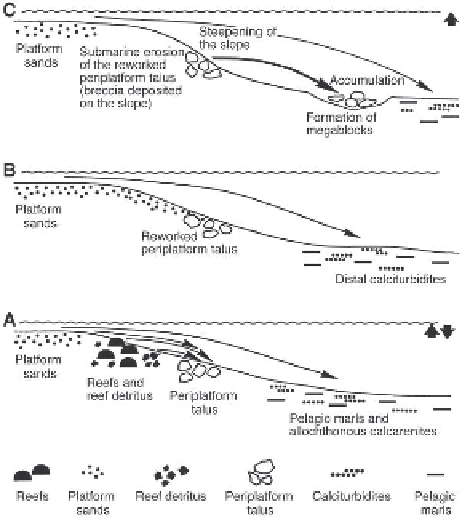Geology Reference
In-Depth Information
includes hummocky surfaces created by creep lobes,
initial dissection of strata, and compressional folds.
Large-scale gravity slides are associated with extended
megatruncation surfaces forming megabreccia sheets.
Examples have been described from the Cambrian and
Cambro-Ordovician (James 1981; Stewart et al. 1993),
Silurian (Surlyk and Ineson 1992), Late Paleozoic
(Franseen et al. 1989) and Triassic (Bosellini 1984,
1989; Heck and Speed 1987).
Sliding and slumping of carbonate sediments occurs
in deep-water as well as in shallow-water environments
(e.g. tidal zones).
Common features that can be studied on an outcrop
scale are
•
15.7.3.1 Permian of Sicily: Megablocks and
BaseofSlope Carbonates
The case study reveals the complex history of alloch-
thonous sedimentation (Fig. 15.21).
The Late Permian of western Sicily is famous for
its abundance of well-preserved fossils. The fossils are
concentrated in large- and small-scale allochthonous
carbonates represented by limestone breccias and
calcarenites forming megablocks and megabreccias in-
tercalated within basinal sediments. The breccias re-
sult from multi-phase debris flows and turbiditic sedi-
mentation. Microfacies criteria and paleontological data
provide evidence of long- and short-term erosion of
Middle- to Late Permian platform-margin and upper-
deformed beds occurring as distinct intercalation
between undeformed beds;
•
welded upper contact in the deformed bed, charac-
terized by a depositional fit between the irregulari-
ties of the upper surface and the base of the overly-
ing bed;
•
the deformed bed may be overlain by limestone con-
sisting of graded or non-graded calcarenites or
calcirudites;
•
deformation of beds as shown by folding patterns;
•
thickening or thinning of folded strata;
•
folded anticlines may be eroded at the upper sur-
face of the deformed bed;
•
preferred orientation of folding axes unrelated to the
tectonic strike;
•
deformed beds displaying a broad spectrum of struc-
tures comprising simple sliding of intact sets of lay-
ers, convolution and distortion of beds, rolled-up
structures, and intensive shearing of dislocated beds.
Most limestones with pronounced slumping struc-
tures are micrites.
Usually no differences can be detected between the
microfacies of slumping beds and the underlying beds.
Some differences have been found in the insoluble resi-
dues of the limestones. Larger amounts of clay-sized
particles in the non-carbonate constituents could have
been responsible for a retardation of early diagenetic
cementation and for changes in the thixotropic behav-
ior of the sediment (Backhaus and Flügel 1971; Kenter
and Schlager 1989).
Fig. 15.21.
Facies model of Permian allochthonous slope
carbonates.
Factors that might have controlled the forma-
tion of the Permian Pietra di Salomone megablock in west-
ern Sicily (modified from Flügel et al. 1991).
Phase
A
: Middle Permian shallow-marine platform with a
reef zone and a periplatform talus zone. Platform- and reef-
derived material is deposited in periplatform position as de-
bris flows and in parts of the pelagic basin as fine-grained
calciturbidites. Phase
B
: Disappearance of the reef zone, pos-
sibly caused by sea-level fluctuations, and reworking of the
periplatform talus, associated with input of platform sands to
the basin. Phase
C
: Steepening of the slope and redeposition
of slope breccias within depressions of the marly basin re-
sulting in the formation of the multi-phase megabreccia now
recorded by the Pietra di Salomone megablock embedded in
Late Permian radiolarian-bearing argillaceous sediments.
Phases A and B took place during the Wordian, phase C some-
time in the Capitanian or later. This is a time range of ap-
proximately 10 ma.
15.7.3 Microfacies of Slope Carbonates:
Case Studies
The following case studies describe microfacies types
of limestones formed in various parts of high-angle and
low-angle slopes and in base-of-slope settings.

